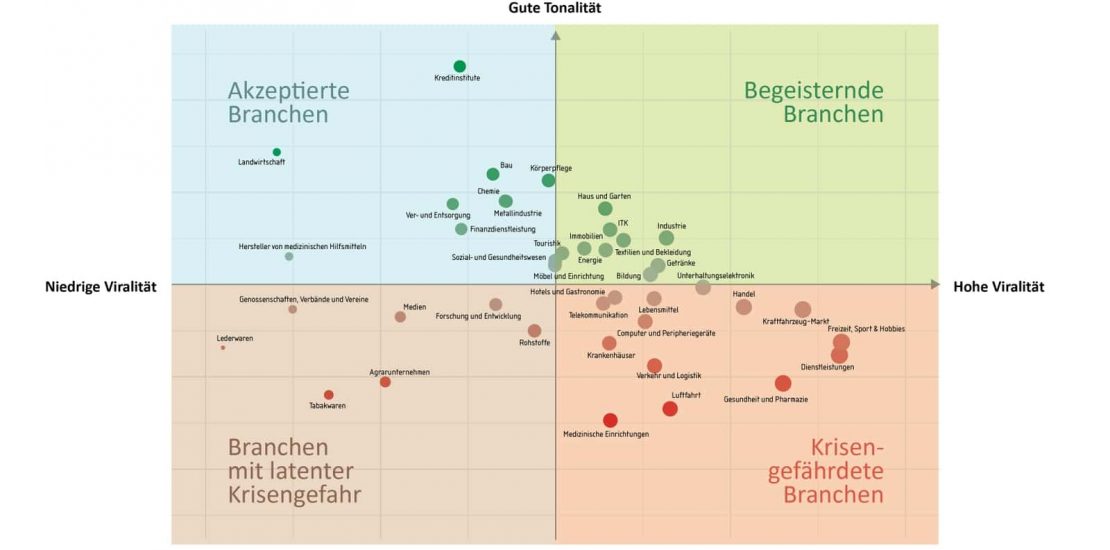- January 25, 2022
- Posted by: Jörg Forthmann
- Category: VIDEOS

- “Crisis map of PR” shows in which industries the risk of communication crises is highest
Hamburg, 25.01.2022 – For some companies, the signs point to crisis, and not only in economic terms, but also in terms of their standing in the public eye. Particularly affected are
Hospitals
and other
medical facilities
, the
Aviation
or the industry
Leisure,Sports & Hobbies
. Being in the public eye is good in principle, but the tone has to be right. The current “Crisis Map of PR,” published by the IMWF Institute for Management and Economic Research, shows who is doing well in the public perception and who is not. IMWF evaluated the public discussion of 20,000 brands and companies from more than 200 industries for the year 2021 with the help of an AI-based social listening analysis with regard to tonality and virality.
Stable reputation
The crisis map is divided into four quadrants. The winner is the company that lands in the upper right-hand corner of the “Inspiring Industries” quadrant, where not only is there a high level of virality, but the positive mentions also outweigh the negative ones. Industries in this sector include home and garden, information and communication technology, industry and real estate companies. Consumer electronics has the highest virality in this quadrant. However, in terms of tonality, this industry is just on the borderline with the “crisis-prone industries” quadrant .
In the upper left quadrant “Accepted Industries,” credit institutions are very high up in the tonality. Good news, even if virality is lower here than in the quadrants to the right of the tonality axis. The construction and personal care sectors are in the same range, but score lower in terms of tonality, but have better virality. Agriculture brings up the rear, at least in terms of virality, in the upper left quadrant “Accepted Industries.”
The problem cases
It becomes problematic in terms of public perception for the candidates in the two remaining quadrants. The “industries at latent risk of crisis” sector includes, for example, agricultural companies, media and commodities. Companies from these sectors are predominantly discussed negatively. However, they can escape major communication crises as long as the underlying topics hardly develop virality. The worst tonality, unsurprisingly, is exhibited by the tobacco industry. All of the industries in this quadrant have in common that they have a preponderance of negative responses, but vary greatly in the frequency of mentions. Branches of the leather industry are mentioned rather rarely, and the raw materials industry is mentioned particularly frequently. The quadrant that no company wants to be in is labeled “Crisis-prone industries.” Those who end up here have a lot of work to do to improve their reputation. Medical facilities have the worst tonality here. Less negative are the reactions to companies in the service industry, but they have a much higher virality. The retail and automotive market sectors are also in negative territory in terms of their public reputation.
Acting with foresight
Those industries that are among the most crisis-prone in terms of negative public reactions actually have a doubly hard time getting out of the reputation hole. The reputation is already tarnished, and good and objective arguments either fall on deaf ears due to the damaged image, or are drowned in the rumbles of various shitstorms. It is therefore crucial to continuously and consistently track and evaluate the public discourse of one’s own brand. “Rather than trying to do damage control after a shitstorm, it’s better to address a communications crisis early on, before it becomes a real crisis. Fortunately, advances in artificial intelligence and the shift of public discussion to digital media mean that this can be largely automated nowadays and therefore can be done with much less effort than a few years ago.”says Jörg Forthmann, managing partner and expert for social listening and crisis communication at IMWF.

To identify which industries are currently particularly vulnerable to communication crises, IMWF recorded mentions of the brands and companies studied in 438 million online sources. The sites were then analyzed for tonality using artificial intelligence techniques. It also recorded how often these posts were liked, shared and commented on to determine their virality.
IMWF – Institute for Management and Economic Research
The IMWF was founded out of the experience that the results of scientific elaborations and market analyses often do not have sufficient practical relevance for decision makers in the economy. As a result, corporate support for scientific institutions often falls short of the chairs’ expectations. Against this background, the IMWF sees itself as a platform on which contacts are established between science and companies interested in well-founded processing of relevant management and business topics.
Press contact
Jörg Forthmann
Managing Director of the IMWF
IMWF Institute for Management and Economic Research GmbH
Phone: +49 (0) 40 253 185 – 111
info@imwf.de
